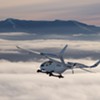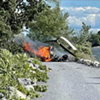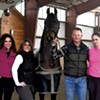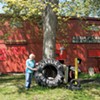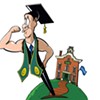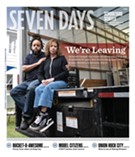click to enlarge 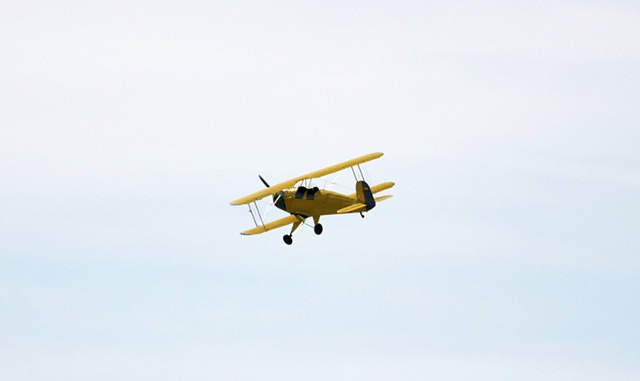
- © Javier Carulo Fotos | Dreamstime
On a recent morning when I stepped outside my house in Charlotte to walk the dog, I heard the hum of a propeller plane overhead. The sound of single-engine aircraft isn't unusual in the area at this time of year. Planes routinely fly to and from Burlington International Airport 18 miles away, and seaplanes fly over Lake Champlain. In addition, Shelburne Airport is eight miles to the north; Basin Harbor Airport in Vergennes, 16 miles to the south. Each of the turf airstrips averages about two dozen flights per week, according to AirNav.com, a website for pilots and aviation enthusiasts.
What drew my attention to this particular plane was the erratic sound of its engine, which was unlike the usual drone of most small crafts. Gazing up, I spotted a bright-yellow biplane performing loops over a nearby field. When I mentioned it to my kids later that morning, my son said that he and his friends had seen similar aerial stunts earlier in the week.
We weren't the only ones. Several other residents in the area posted comments on Front Porch Forum about the aerobatics, as such stunt flying is called.
"Totally enjoyed the little air show today!" wrote Charlotte resident Sue Schermerhorn in a July 8 post. "Pilot looked like he was having a great time, too."
"We also enjoyed watching the acrobatics," Tom Bove of North Ferrisburgh posted the following day. Bove noted that his father was a pilot and used to do similar stunts in the 1960s. "It's great to see someone keeping the art alive," he added.
But not everyone on the ground appreciated the attitude, or altitude, of the aerial maneuvers, much less the hour of the morning when they commenced.
"It's quite a show. But over people's homes?" wrote Megan Price of Charlotte in a June 9 post. "Since when did this area become the playground of a Blue Angels wannabe?... Fly high, fly safe, and keep going, please!"
Like fireworks shows, aerobatics aren't everyone's cup of tea. While some people ooh and ah at the aileron rolls and stall turns, others immediately google the Federal Aviation Administration's complaint line.
So, what are the rules regarding aerobatics? Robin Guillian is director of Vermont Technical College's Professional Pilot Technology program. A certified flight instructor and former commercial airline pilot, Guillian explained that all planes must abide by FAA-mandated "minimum safe altitude" requirements. Those vary depending upon what the plane is doing and where.
Generally speaking, she said, pilots must fly at an altitude that allows them to make an emergency landing if the aircraft loses power, "without undue hazards" to people and property on the ground.
"So, let's say you're flying at 2,000 feet and your engine goes, and you manage to land in a field and not kill yourself," she said, "but, unfortunately, you take out a fence and a cow on the ground. You would be considered breaking federal aviation regulation."
Additionally, under FAA regulation 91.303, which covers "special flight operations," "No person may operate an aircraft in aerobatic flight over any congested area of a city, town or settlement ... [or] over an open air assembly of persons." Think a Lake Monsters game or a high school graduation.
Air shows, like those held periodically on Burlington's waterfront, receive temporary FAA authorization to perform those maneuvers near crowds.
Aerobatics are also prohibited within four nautical miles of a federal highway, below 1,500 feet or when flight visibility is less than three miles. Guillian said that when she takes her instructors up to perform such moves, they're done at about 6,000 feet. "So, if you ever see someone doing aerobatics low, it's not me or my students," she added.
One Charlotte resident who saw the aerobatics plane jotted down its tail number: N98TS, or, in the phonetic alphabet of aviation, November 98 Tango Sierra. (This is the Whisky Tango Foxtrot column, after all.)
According to the FAA aircraft inquiry website, the plane is a German-built Extra 300. However, the FAA noted that it's not a biplane but a monoplane registered to Beta Technologies of South Burlington. Evidently, more than one aerobatic plane is performing stunts. Beta Technologies made news last week when one of its pilots crash-landed a helicopter on the Colchester Causeway and walked away with only minor injuries.
A spokesperson for Beta confirmed that its fleet includes aerobatics planes, including the one identified over Charlotte. The electric aircraft startup encourages all of its employees to obtain a pilot's license and pays for their instruction and flight time.
Matthew Edson, a former F-16 fighter pilot who now works as a flight instructor at Beta, explained that he uses the aerobatics plane for training pilots on spin awareness and upset recovery — potentially lifesaving techniques — as well as for teaching competitive aerobatics.
"We do it in a variety of locations and obviously well within the federal regulations and the guidelines put forth by the Federal Aviation Administration," he said.
But with more than 45 certified pilots at Beta, several of whom fly the aerobatics planes, Edson couldn't say, without knowing specific dates and flight times, who might have been flying over southern Chittenden County.
If members of the public are ever concerned about the performance of a particular plane, such as how low it's flying, Guillian suggested they call the control tower at Burlington International Airport. Even if you're really bad at estimating altitude, don't worry about it, she said. Air traffic controllers should be able to see it on their radar.
"And if they're not on the radar, they're definitely flying too low!" she said with a laugh.









































